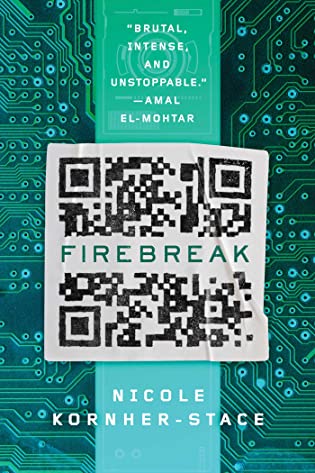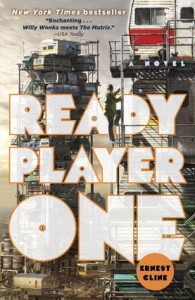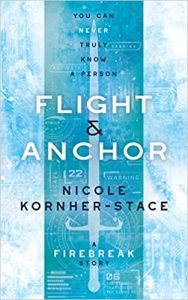 Firebreak by Nicole Kornher-Stace
Firebreak by Nicole Kornher-Stace Format: eARC
Source: supplied by publisher via Edelweiss
Formats available: hardcover, paperback, ebook, audiobook
Genres: dystopian, science fiction
Pages: 416
Published by Gallery / Saga Press on May 4, 2021
Purchasing Info: Author's Website, Publisher's Website, Amazon
Goodreads
Like everyone else she knows, Mallory is an orphan of the corporate war. As a child, she lost her parents, her home, and her entire building in an airstrike. As an adult, she lives in a cramped hotel room with eight other people, all of them working multiple jobs to try to afford water and make ends meet. And the job she’s best at is streaming a popular VR war game. The best part of the game isn’t killing enemy combatants, though—it’s catching in-game glimpses of SpecOps operatives, celebrity supersoldiers grown and owned by Stellaxis, the corporation that runs the America she lives in.
Until a chance encounter with a SpecOps operative in the game leads Mal to a horrifying discovery: the real-life operatives weren’t created by Stellaxis. They were kids, just like her, who lost everything in the war, and were stolen and augmented and tortured into becoming supersoldiers. The world worships them, but the world believes a lie.
The company controls every part of their lives, and defying them puts everything at risk—her water ration, her livelihood, her connectivity, her friends, her life—but she can’t just sit on the knowledge. She has to do something—even if doing something will bring the wrath of the most powerful company in the world down upon her.
My Review:
Firebreak isn’t about the game. Not that there isn’t one, and not that Mallory and her best friend Jessa aren’t playing it, but the story in Firebreak is not really about the game. Especially not to the degree that Ready Player One is about the game and the puzzle about the ownership of the game every bit as much as it is concerned with the near-future dystopia in which the story is set.
But they do have something in common – in both stories the game is the opiate of the masses that keeps people from thinking too hard or too long about all the many, many ways in which they and their worlds are totally and epically screwed.
Mallory and Jessa, and every single person they know in Old Town, outside the walls and checkpoints of New Liberty City – where all the elites live – is a survivor of the corporate wars between Stellaxis Innovations and Greenleaf Industries.
The war may have mostly devolved into an uneasy peace interrupted by intermittent skirmishes, but when the war was going hot and heavy mechs and artillery were everywhere, everyone lost family, friends, loved ones, homes and livelihoods. Most of their friends are the ONLY surviving members of their families.
Stellaxis controls water, and Greenleaf controls food. Living in a Stellaxis controlled area, with 9 people crammed in one room of what used to be an old hotel, they queue up every day for their meager water ration and work three, four or even six jobs to pay for rent, food and everything else.
An everything else which includes the in-game credits and items needed to stream their participation in the game BestLife. Which is, ironically, a simulation of the corporate wars.
Mal and Jessa’s gaming stream gets them just enough credits and in-game items to keep them going – albeit barely and on a shoestring. So Jessa jumps at the chance of a high paying sponsor – no matter how skeevy and weird the arrangement seems to be.
Mal is a whole lot more skeptical – but then Mal is just plain skeptical of people in general.
That would-be sponsor turns out to be, not even a small-time corporation, but instead a locked-out conspiracy theorist who might just have the parts of a key that leads to the largest and most dangerous Pandora’s Box of all time. A box that holds the biggest and dirtiest secrets that Stellaxis Innovations has buried in the deepest, darkest subterranean levels of their vast corporate complex.
Literally.
The truth might set Mal and Jessa and everyone they know, free of the corporate oversight that controls their every waking moment. Or it might get them all killed. Slowly by dehydration and kidney failure. Or as quickly as a bullet in the head.
 Escape Rating A+: It’s not about the game. It’s about the world that the game lets everyone escape from while packaging and selling the war – and every control and draconian measure that goes along with it – to everyone at the same time.
Escape Rating A+: It’s not about the game. It’s about the world that the game lets everyone escape from while packaging and selling the war – and every control and draconian measure that goes along with it – to everyone at the same time.
Firebreak is the story of someone who has spent her life keeping her head down and putting one foot in front of the other, always on the brink of exhaustion, dehydration and starvation – just like everyone else she knows.
At 20ish, Mal is just barely old enough to remember a time before, that life didn’t used to be like this. She’s part of the last cohort to know that there used to be a better way – but she’s too tired and downtrodden to do anything about it.
So the story here is about Mal waking up and trying to do the right thing, or at least a potentially right thing, before it’s too late.
Once she sees the evidence that at the center of the war that Stellaxis has merchandised and sold to everyone is an unforgivable crime, she realizes two things. That someone has to do something. And that that someone is going to be her. Because she can’t unsee what she’s seen and she can’t unknow what she knows and she can’t let it go.
Because she might have been one of the orphaned children who got sucked in, brainwashed, genetically engineered and spit out to be the supersoldiers that sell the merchandise that funds the war. For as long as they live.
The story in Firebreak is about a scrappy, scared, struggling attempt by one “little” person to make a world-spanning corporation take just a tiny bit of responsibility for the evil that they’ve done. An evil that they bring fully to bear on anyone who lifts even a corner of their penthouse suite rug to see just how much dirt got swept underneath it.
Mal is naive, skeptical, and very definitely punching way above her weight class. A fact that is brought home to her with extreme brutality, over and over and over. But she can’t stop trying to do the right thing – even when so much of that attempt goes totally wrong.
In the end, we’re not sure she’s succeeded. And we’re really not sure it’s going to last. But her journey, every heartbreaking, pulse-pounding, sweat-dripping moment of it, keeps the reader on the edge of their seat until the very last page, hoping that there’s just a tiny bit more.
Firebreak is not nearly as much like Ready Player One as the blurbs might lead one to believe, because it’s not about the game at all – meaning that you don’t need to be a gamer or any memory at all of any era’s pop culture iconography.
 The way that Firebreak DOES link to Ready Player One is in the way their dystopian settings do – or mostly don’t – work for most of the people who live in them. The world of Firebreak reads like what would have happened to Wade Watts’ world in RPO if Wade had lost the game and the evil corporation had taken over the OASIS. Possibly blended with just a bit of the dystopian setting of Veronica Roth’s Poster Girl with its conspiracy theories, mega-corporation spin doctoring and propaganda, and particularly the shared secrets at the hearts of their power structures.
The way that Firebreak DOES link to Ready Player One is in the way their dystopian settings do – or mostly don’t – work for most of the people who live in them. The world of Firebreak reads like what would have happened to Wade Watts’ world in RPO if Wade had lost the game and the evil corporation had taken over the OASIS. Possibly blended with just a bit of the dystopian setting of Veronica Roth’s Poster Girl with its conspiracy theories, mega-corporation spin doctoring and propaganda, and particularly the shared secrets at the hearts of their power structures.
Firebreak is an absolutely compelling read – with more than a touch of ominously prescient chill – from beginning to end. When I finished it I really wanted just a bit more – and that more is almost here.
A Firebreak prequel novella, Flight & Anchor, is coming in June. I know I’m going to get my heart broken all over again, but this is one of those times when I’m absolutely there for it.
